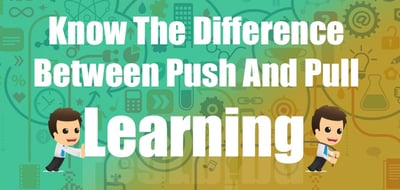Pull learning is trending. And for very good reason. Not only is it an effective way to digest important information, but it's also much more efficient in today’s fast paced world.
To understand the benefits of it, you must know what it is and how ipush and pull learning differ.
Push Learning: The Traditional Track
Push learning is a traditional learning approach where learners are essentially told what and how much they must learn.
According to Aurion Learning, “like a school curriculum which is laid out module by module, traditional push e-learning programmes follow a similar cycle: Learners work through each module in sequence and take the assessment at the end to test their knowledge. Each module is compulsory… the final assessment tests their learning on the entire programme”.
Although there are some advantages to this style—completion of the program can be confirmed; learners are familiar with the format—it can also be cumbersome and time-consuming. These are just some of the reasons many companies are shifting training to such an innovative style.
Pull Learning: A More Modern Method
Much of the pull-based genius lies in its on-demand approach, which more closely aligns with our on-demand culture’s expectations. Different from the traditional educational structure, pull learning allows learners “to access at the point of need and find compressed nuggets of content that can help them with specific tasks or workflow” (Clomedia).
As a learner, this method give you more control—you can access and digest the information right when you need it without having to jump several hurdles before getting to it. This allows students to tailor their learning experience to their own needs based on job roles, personal knowledge, and career interests.
A Slow Shift
While the benefits seem obvious, the shift within professional industries has been gradual. It has been more than 15 years since e-learning began transitioning from the conventional push to the pull methodology.
Rolling out any new internal program is never easy—companies are pressed for time and money and employees are curious but skeptical. For it to really work, employers and employees both must profit from this fresh learner-based approach. According to digital learning consultant Tim Drewitt, “If more organizations encouraged and enabled pull learning, they’d see greater utilization of the wealth of content that’s probably gathering ‘virtual dust’ in their learning management system and reducing the return on investment.”
With technology rapidly evolving it makes good business sense for organizations to invest in a modern learning system. Not only will it allow the business to remain competitive in their respective industries, but it keeps colleagues interested and invested, allowing them to grow personally and professionally. And, it’s certainly a draw for young professionals and the Internet generation, who have high expectations for how companies will train and retain them.
Need more information on how to attract Millennials? This handy guide can help!
